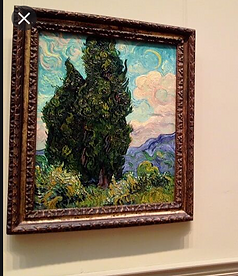
Met Museum Analysis
The piece I have chosen to discuss for the virtual analysis is the “Cypresses” by Vincent Van Gogh. Cypresses was created in late june of 1889 during the 19th century. Vincent Van Gogh painted this in France, while he stayed in a year long asylum in Saint-Remy. This painting is a landscape; including a series of cypress trees, a wheat field, the moon, and the scenery of clear skies in the background. Initially, Vincent Van Gogh was allowed to paint in the asylum garden. He painted the view of a wheat field from his window, but later went out into the countryside where he was accompanied by an asylum staff member. This painting caught my eye from the beginning, ever since I was eleven years old, because it has bright and dark colors, and it reminds me of an old, similar painting my grandfather painted before passing away. The painting also caught my eye because it is painted in curves, which is also rarely seen by other famous painters and makes the painting unique.I really like the combination of dark and bright colors Vincent Van Gogh used in order to represent the scenery of his window view in France. I was very lucky to be able to analyze the painting at such a young age and have the privilege to live close to the MET museum and be able to visit the painting whenever.
The first feature I would like to highlight is the work’s details. Everything is painted in curves: the cypress trees, the grass, the baby-blue sky, the clouds, the silver hills that rise and fall in the background, and the crescent-shaped yellow moon standing out against the blue backdrop. The objects are very fluid; the trees and the grass in the foreground look like they're swaying in the wind, the clouds seem to be in a gentle drift, and the sky seems windy. This allows the viewer to create an imagery in their head to be able to further comprehend and imagine the painting as if it was reality. If you let your eye follow one curve, it seems like you can follow it around the whole painting, it's as though Van Gogh painted the entire scene with one stroke of his paintbrush. Another aspect I would like to highlight are the materials used to create this painting. Vincent Van Gough used thick impasto to create the painting; a technique where paint is laid on an area where the surface is thick, usually thick enough that the brush strokes are visible. Vincent Van Gogh also used the technique of “post impressionism” as the genre to imply the naturalistic description of light and dark color. The size of this painting is 93.3 x 74.0 cm. Vincent Van Gogh used light colors like baby blue, yellow, and white to represent the scenery of the blue skies and clouds from his perspective of what the view in the asylum looked like. He uses darker colors like dark green, a darker blue, and light green to highlight the cypress tree, the wheat field and the mountains in the back. This painting is a closed shape painting, meaning that it is enclosed by a definite edge. Vincent Van Gogh's use of color is usually rich, and lines of different colors run side by side or a point of different color suddenly appears. We see that Vincent Van Gogh does use gradual color change in this painting. We spot a gradual color change within the baby blue used for the sky, and the white used for the clouds, into light pink to represent the sun setting or rising in an early morning or late afternoon.
I will never forget the moment when I first saw cypresses at the MET museum and instantly thought of every meaning it could have behind it or what the reason was for painting the beautiful scenery of Saint-Remy. In my opinion, after I read the reading “Ways of seeing”, a quote that stood out to me was “seeing comes before words”. While looking at cypresses, I thought of that quote because I had my own vision and thoughts of the painting that I imagined before I knew that Vincent Van Gogh was painting a wheat field from his asylum view in France. I believe that although we know what Vincent Van Gogh is painting, we tend to think outside of the box to further comprehend the artist's mind. As I analyzed this painting, I thought of different wheat fields I knew or similar places that would have a similar scenery in order to truly picture what the painter is trying to imply in the painting.


